
WGI Unleashed Episode 89: Lyndsey Duty, Environmental Scientist
On the latest episode of the WGI Unleashed podcast, we sit down with Lyndsey Duty, one of WGI’s Environmental Scientists based out of our Tampa, FL office!
Learn from award-winning professionals — explore our whitepapers, blogs, and the latest industry updates.
Join our dynamic organization of engineers, land surveyors, landscape architects, environmental scientists, and architects!
Talk to a market leader today! We’ll answer any questions you have about our professional services.

With the continued development of land and the increase of infill redevelopment, more and more people are moving into cities. Adding trees and increasing canopy within our cities provides well-documented gains ranging from environmental to social, health, and economic benefits.
Urban trees provide a variety of positive environmental benefits, particularly air purification. Trees absorb harmful pollutants such as nitrogen oxide, ammonia, and sulfur dioxide, and trap fine particulates like dust, pollen, and smoke. Trees also play an important role in mitigating climate change, absorbing hazardous carbon dioxide (CO2), storing the carbon, and releasing oxygen. Studies show that in one year, an acre of urban trees can absorb the equivalent CO2 produced while driving a vehicle 26,000 miles.
Urban trees also assist in water purification; tree leaves and roots filter water and remove pollutants. Trees reduce water runoff, helping recharge water tables. Trees also aid water conservation by minimizing water evaporation in the surrounding landscape.
Numerous studies show urban trees’ provide many social and health benefits. Trees give neighborhoods an identity, fostering a sense of community. Urban landscapes increase residents feelings of safety; promoting trust between neighbors and encouraging social interaction while helping to reduce crime.
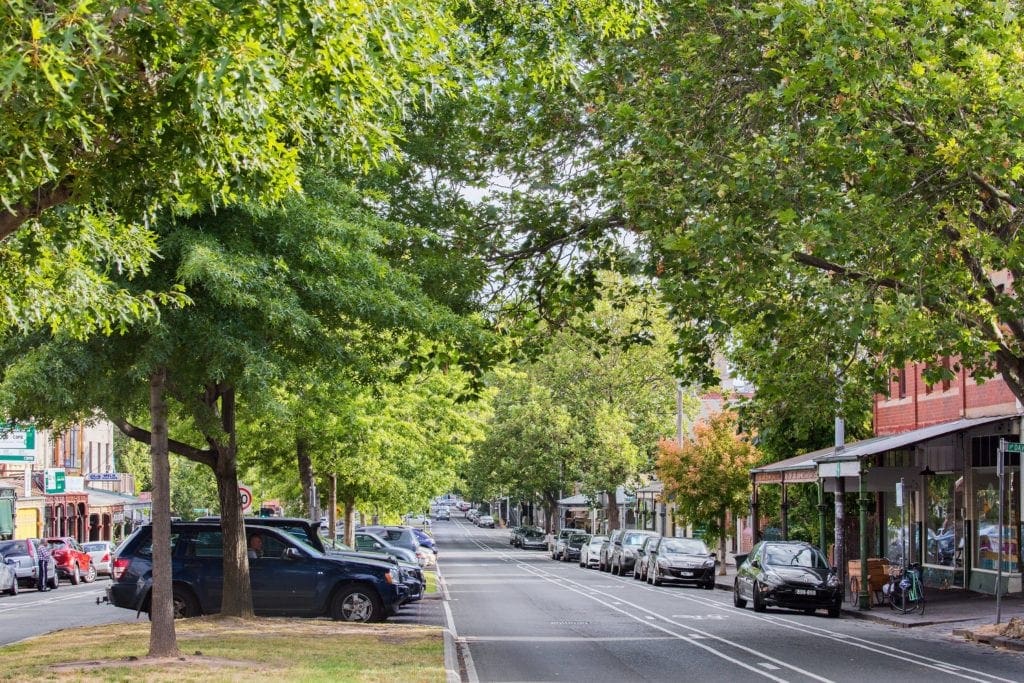
There are multiple health benefits associated with incorporating trees into the urban environment. Studies show that incorporating natural tree and plant systems assists in reducing blood pressure and stress for residents. The cleaner water and air lead to healthier people within these urban areas. Trees also reduce the “heat island effect,” cooling the area and providing a more pleasant microclimate. This encourages adults and children to spend more time outdoors being active, leading to a healthier lifestyle. For children, these benefits also assist them in developing essential social skills.
Urban trees also provide economic benefits to the community, residents, and business owners. Providing smart planning of tree locations can help conserve energy and save money for residents; proper placement of trees around structures can reduce air conditioning and heating costs by 30%.
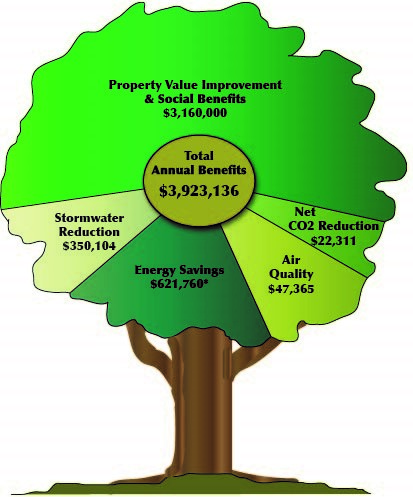
Including trees within the urban landscape can also significantly affect property values as much as 20% – as well as increase tourism and business interest.
As trees continue to grow, their ability to provide all of these benefits amplifies. It was once stated that trees are the only infrastructure element that grows in value over time. With that concept in mind, and considering all the benefits trees provide, protecting existing canopy and supporting successful growth of installed trees is crucial to the success of our urban environments.
As development increases, so increases the need for infrastructure elements, including overhead and underground utilities, fiber optic, drainage elements, signage, and lighting elements. Many times these elements also include large easements or regulatory horizontal and vertical offset clearances.

Quite often, trees and landscape elements take a backseat to these other infrastructure elements, particularly in tight urban environments. The successful growth of urban trees requires consideration of their needs. This includes providing for significant root growth, horizontal clearances from roadways, clearances from buildings and lighting, etc. With thoughtful consideration, many of the trees’ requirements can coalesce with other infrastructure requirements. For example, ensuring utilities are planned within required tree roadway offset clearances, instead of prime locations for tree installations. Other efforts include providing soil cell technology under sidewalks which utilities could run through, protecting the utility and sidewalk while providing adequate soil volumes for successful tree growth. Landscape architects and planners need to work with utility and civil engineers to take a holistic approach to the overall infrastructure design and ensure that urban trees are equally considered as a vital infrastructure element.
Resources:

WGI is a national design and professional services firm leading in technology-based solutions for the construction of public infrastructure and real estate development. At WGI, we’re providing Tomorrow’s Infrastructure Solutions Today.

On the latest episode of the WGI Unleashed podcast, we sit down with Lyndsey Duty, one of WGI’s Environmental Scientists based out of our Tampa, FL office!

WGI’s San Antonio team laced up their running shoes and braved the rain to take on the iconic Rock and Roll 5K – Discover how they turned challenges into triumphs in this memorable event recap!

With a legacy of supporting, empowering, & inspiring women in transportation, the WTS Central Florida’s Annual Awards & Scholarship Banquet was nothing short of a night to remember.
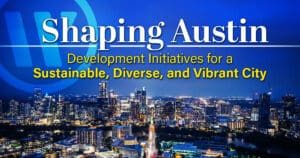
Discover how Austin is transforming urban development with proposed zoning changes, inclusive housing initiatives, and creative space preservation—all while embracing growth and sustainability.
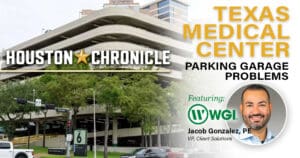
Texas Medical Center made $78M from parking last year. Why haven’t its busiest garages been upgraded in years?
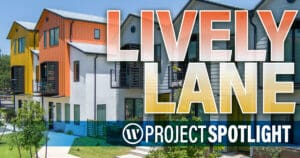
Discover how WGI helped bring Lively Lane to life—a vibrant community in San Marcos that blends sustainable design, live/work townhomes, and natural beauty to create the perfect balance of urban convenience and serenity.
You’ve been searching for a place like WGI. We look forward to meeting you soon.
Sign up to receive emails to hear our latest news and achievements in our monthly newsletter.
Enter your zip code, and we’ll personalize your experience with local projects, office locations, team members, and more.
WGI supports its associates with meaningful opportunities for growth, strong benefits and perks, while we work collaboratively with clients and co-consultants to shape and improve communities.






WGI is a dynamic organization with opportunities nationwide for engineers, land surveyors, landscape architects, environmental scientists, and architects.